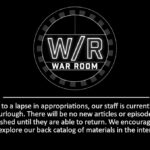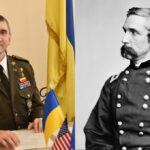
The oldest depictions of combat, found in Iberian cave art of the Mesolithic, show battles between archers. A group of three archers encircled by a group of four is found in Cueva del Roure, Morella la Vella, Castellón, Valencia. (Eduardo Hernández Pacheco via Wikimedia)
EDITOR’S NOTE: This is the seventh installment in a multi-part series that examines how professional military education should be designed. This and subsequent articles will look through the lens of the competencies required of officers as the global security environment changes once again. The collection of articles can be found in a collection here once they have been published.
Today, nearly every single article or book discussing the possible impact of military AI, references that one famous quote by Vladimir Putin: “Whoever leads in AI will rule the world.”
Since the dawn of history, warfighting has gone hand-in-hand with technological innovation. With the risk of sounding technologically deterministic, one could hardly deny the importance and centrality of the available war technology at any battle, campaign, and war effort. Students of military history are bombarded with stories about how the stirrups or the gunpowder transformed not only the way wars were fought, but the extended socio-political structure of whole continents. Today, nearly every single article or book discussing the possible impact of military AI, references that one famous quote by Vladimir Putin: “Whoever leads in AI will rule the world.” An entire field of organizational studies, namely innovation studies, has been created to study exactly the circumstances under which innovation can foster, which actors can most suitably promote innovation, and how innovations might be militarily effective through proper implementation. But less attention has been drawn towards the relationship between technological innovation, and those who are most affected by it; in other words, the military professionals tasked with implementing, planning, and using it.
When a new technological innovation is introduced, the surrounding discussions focus on its applications, its possible effectiveness, and how to best make sure it predictably and consistently remains functional. How military professionals will use it becomes the purview of training experts, who painstakingly design appropriate training regimes for their use, how to adapt to cases of malfunction or complete system failure, and how to coordinate with colleagues around the new technology. Here, I argue that there is an overarching set of key competencies that professional military education (PME) programs should aim to develop in the officers, not only those whose tasks and expertise will be most closely tied to the any new technology, but all of them. This article is therefore trying to address the questions of what are the key technology and innovation-related competencies that program designers and owners should aim to develop, and what challenges might they encounter in their efforts? Through the examination of these questions, the article argues that, while each technology brings its own particular challenges, there is a set of organizational and sociologically informed points of pressure, that if appropriately and systematically addressed, will be beneficial in preparing officers for the wars to come. The answer suggested here is a separate, comprehensive education track within the PME programs that is created and tailored for preparing officers for working with and around new military technologies. Finally, I do not claim that this approach does not already exist in some capacity in PME programs, but that their systematization through the lens of the key competencies will provide officers with an across-the-board set of skills, which might otherwise be fragmented or ad hoc.
Key Competencies in Technology and Innovation
It is important to note at the outset that some of the competencies required to adapt to innovative technologies apply to other subjects as well, and so intersect with other elements of PME curricula. It is not the argument of this article that these competencies are unique to innovation; some competencies are also useful in dealing with existing technologies. For instance, basic problem-solving skills will benefit officers and prepare them for new and future technologies but are also useful for basic elements of joint operations, especially within alliances like NATO. But technology becomes a particular consideration in military organizations, and oftentimes officers are called to become key players in influencing new weapon acquisition processes. Such skills should be developed with an eye towards systematizing the inclusion of officers in such processes as advisors, which will prove beneficial for acquiring and adopting technologies. The insight provided by officers is informed by experience, which must then be translated into administrative language and procedures. Yet including practitioners in these influential decisions can have a positive impact on morale and a general sense of participation.
Adjacent to this competency, is understanding the mutual interactions among technology, organization, and doctrine. All these separate components are, in some way, addressed during PME, but I suggest that they should be combined in one, in-depth course that synthesizes doctrinal demands, organizational realities, and technological capabilities. New technologies usually come with an ambitious set of promises for what they will achieve, but this initial excitement soon faces the realities of what is necessary and achievable. Having prepared officers to think in holistic terms in regard to how new technologies should be acquired, implemented, and used vis-à-vis the strategic goals of the state, any alliance activities and obligations, and what the national armed forces are capable of, will prove beneficial for the timely, efficient, and effective adaptation to new developments, both strategic-political and technological.
[N]ew technologies can pose significant risk for the officer’s psychological and mental state.
Other key competencies relevant to new and future technologies stem from the nature of new technologies themselves; one is the ability to manage uncertainty, both in terms of recognizing and understanding the human limitations that new technologies might impose, and in terms of the level and amount of trust that officers should place on intelligence that might be subjected to deception, data manipulation, and interference. In regard to human limitations, in his book The Problem with Pilots historian Timothy Schultz explained how the physical limitations of the human body and mind slowed the development of aviation technology and the efforts of pilots, engineers, and flight surgeons to overcome these hindrances. A program that addresses similar obstacles with new technologies would prepare officers as to how they might best adapt to new technological demands; this can not only help the armed forces save time and resources but prevent injuries or even casualties. Finally, new technologies can pose significant risk for the officer’s psychological and mental state. Especially with the use of drones, as well as the advent of AI and more autonomous systems, officers will benefit from undergoing extensive psychological training to prepare for and ideally mitigate the moral injury that new technology seems to bring.
New and future technologies come with heightened levels of vulnerability and complexity, offering novel ways to exploit existing weaknesses and create new ones. Coming to the issue of deception and data manipulation, this is an old problem that warfighters have always had to deal with: how much do you trust the info that has been collected? While this answer is usually highly contextual and requires experience and critical thinking skills that can only be taught at a program to a limited degree, a track focusing on new technologies can train officers in ways to manage uncertainty, as well as training them in those exact methods of interference and manipulation themselves. If the vision of centaur teams becomes reality, the symbiotic relationship between humans and machines will require trust, certainty, and predictability, as well as tactics for exploiting equivalent vulnerabilities in enemy forces.
Finally, new technologies threaten to disrupt or affect the established status hierarchy and task allocation within the armed forces, and as such the topics of group and subgroup culture, functions, and force mission have to be addressed with an eye towards technology. Especially in services that rely heavily on technology for their tasks—such as air forces—the internal hierarchy is built on the respective status and prestige that a position has. Fighter pilots, for example, enjoy elevated status, with higher promotion opportunities than other types of pilots. With the advent of the use of drones, as well more autonomous systems in the future, this hierarchy might be shaken, or at the very least internal tensions might arise. An education track that emphasizes the organizational mission as the primary consideration will imbue students with the notion that technology is a tool, rather than a source of status. This approach will be beneficial for morale, as well as towards mitigating the initial pushback that new technologies face and facilitate the timely and effective adoption of the new technologies, especially in the modern competitive environment.
Who benefits from this approach?
It would be advantageous for NATO member states to establish new technology-oriented tracks within their PME programs for another important reason: to ensure the maximization of the interoperability of their respective systems. While the interoperability of systems between services as well as allies is primarily affected by the technological compatibility of various systems and the political willingness of states to work with allies towards higher and deeper synchronization, military officers are the end users of these systems, and thus require a high level of understanding the requirements of maximized interoperability. This competency is also closely connected with the importance of maintaining an understanding of the connection between doctrine, organization, and technology, and this becomes even more important within the context of NATO, an alliance in serious need to maintaining tight cohesion and cooperation. In conclusion, the realities of modern strategic competition, paired with the centrality of new and future technologies in war emphasize the need for establishing a cohesive and comprehensive track in intermediate PME. Preparing officers for what is to come by developing the necessary, key competencies for achieving the optimal acquisition, adoption, and implementation of new technological innovations will not only increase military effectiveness, but also morale as well as job satisfaction, potentially resulting in higher retention rates and fewer negative consequences that new technologies bring along with them.
Vicky Karyoti is a post-doctoral fellow at the Swedish Institute of International Affairs (UI), where she holds the title of Transatlantic Researcher. She has a PhD in International Politics from the University of Southern Denmark. Her research focuses on the impact of new military technologies, military professionalism and sociology, and international security. She has also published works on the European Strategic Autonomy initiative, and Great Power competition.
The views expressed in this article are those of the author and do not necessarily reflect those of the U.S. Army War College, the U.S. Army, or the Department of Defense.
Photo Description: The oldest depictions of combat, found in Iberian cave art of the Mesolithic, show battles between archers. A group of three archers encircled by a group of four is found in Cueva del Roure, Morella la Vella, Castellón, Valencia.
Photo Credit: Eduardo Hernández Pacheco via Wikimedia





As reported in The AEF Way of War: The American Army and Combat in World War I by Mark Ethan Grotelueschen
various divisions in the AEF understood and adapted to the new realities of war with machine guns, poison gas and trenches. Some generals understood the new changes and other division the regiments had to adapt even though the generals had not.
In the British Army before World War II, many mid rank officers had only served in infantry divisions and had little experience with tanks. Yet, they didn’t want to be shut out of promotions even though they did not understand armored tactics.
We will have to see what adaptations arise with the advent of drones and jamming and other innovations. Like battleships, it may be the case that the day of the tank may be over. I don’t know. It may be that the role of the sniper may be over with drones with thermal imaging.
We may see all sorts of countermeasure for drones and imaging systems. I don’t know.
What I think is the greater danger is the current industrial base and the current armed forces the process for acquiring weapons and other necessities. I wonder whether we have the ability to replace losses of trained men in a coherent fashion. I wonder whether we have the ability to take the lessons on the battle space and change the current training to incorporate what is the new reality.